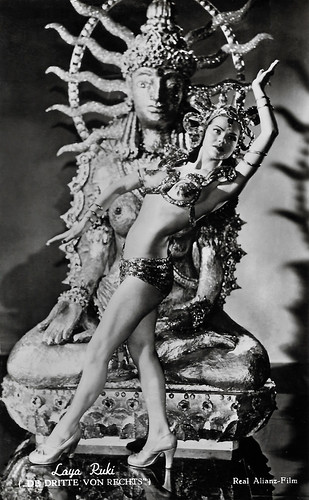
West German postcard. Photo: Real / Allianz Film. Laya Raki in Die Dritte von rechts/The Third from the Right (Géza von Cziffra, 1950).
Exotic dancer and film actress Laya Raki (1927-2018) was a popular sex symbol in Germany during the 1950s. She appeared in revealing outfits in film and photographs, capturing men's attention like no German showgirl. Later she also became an international star with her roles in British films and TV productions.
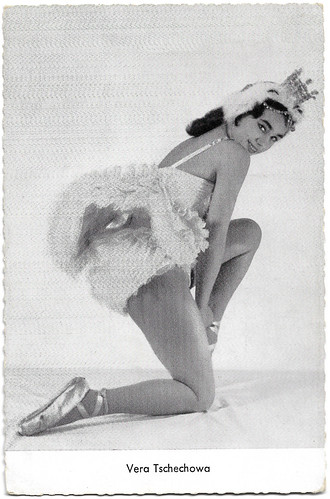
West German postcard by Kolibri-Verlag G.m.b.H., Minden (Westf.), no. D 95.
Vera Tschechowa (1940) is a film and television actress and director of German-Russian descent. Her grandfather was Oscar-nominated actor Michael Chekhov who was the nephew of author Anton Chekhov. Her grandmother was legendary film star Olga Tschechowa. The elegant, green-eyed actress has appeared in over 50 films since 1957.
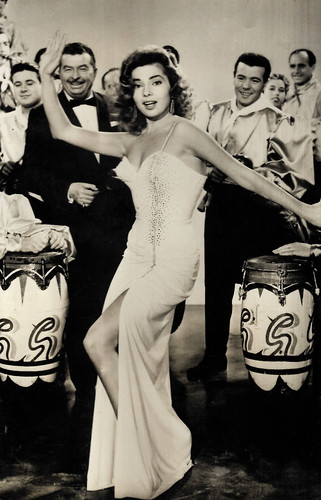
Spanish postcard by Ediciones J.R.B., no. 85/4. Photo: Ceo. Abbe Lane and Xavier Cugat's Orchestra.
Va-va-voom singer Abbe Lane (1932) achieved her greatest success as the vocalist for Xavier Cugat's orchestra, but she also appeared in several American and Italian films. The beautiful, curvaceous Lane was nicknamed 'the swingingest sexpot in show business.'
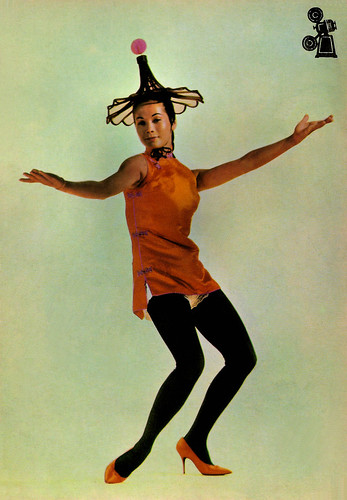
Spanish postcard by Postalcolor, Hospitalet (Barcelona), no. 123, 1964. Photo: Sirman Press. Nancy Kwan in Flower Drum Song (Henry Koster, 1961).
Chinese-American actress Nancy Kwan (1939) played a pivotal role in the acceptance of actors of Asian ancestry in major Hollywood film roles. She is best known for her debut as a free-spirited Hong Kong prostitute who captivates artist William Holden in The World of Suzie Wong (Richard Quine, 1960). She followed it the next year with the hit musical, Flower Drum Song (1961). Kwan spent the 1960s commuting between film roles in America and Europe.
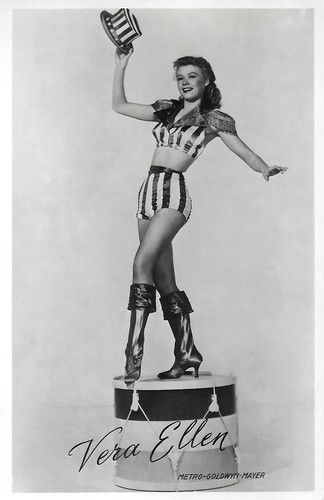
Dutch postcard by Takken / 't Sticht, no. 561. Photo: Metro-Goldwyn-Mayer.
Blonde, slim Vera-Ellen (1921-1981) was one of the most vivacious and vibrant musical film talents to glide through Hollywood in the 1940s and 1950s. Whether performing solo or dueting with the best male partners of her generation, including Fred Astaire, Gene Kelly and Donald O'Connor, Vera-Ellen gave life to some of the most extraordinary dance routines ever caught on film. She was a dance sensation in a string of light-hearted but successful films. Vera-Ellen retired from acting in the late 1950s.

Dutch postcard by Takken / 't Sticht, no. 734. Photo: Metro-Goldwyn-Mayer. Leslie Caron and Gene Kelly in An American in Paris (Vincente Minnelli, 1951).
French film actress and dancer Leslie Caron (1931) was one of the most famous Hollywood stars in the 1950s. She is best known for the waif-like gamines in musical films like An American in Paris (1951), Lili (1953), and Gigi (1958). Since the 1960s she also worked in the European cinema.
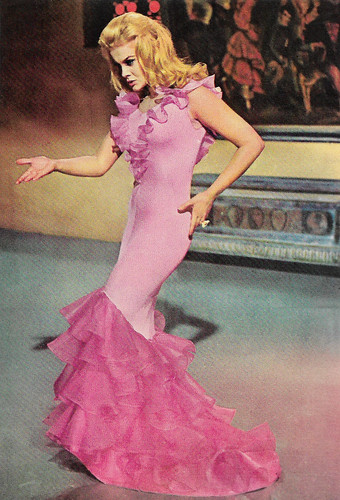
Spanish postcard by Postal Oscarcolor, no. 422. Photo: Ann-Margret in The Pleasure Seekers (Jean Negulesco, 1965).
Ann-Margret (1941) is a Swedish-American actress, singer and dancer, with a career that spans five decades. Her trademarks are her breathless voice, strawberry blonde hair and voluptuous figure which lead to the nickname 'sex kitten'.
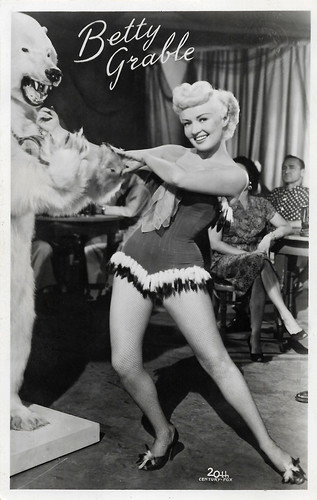
Vintage postcard, no. AX 846. Photo: 20th Century Fox. Betty Grable in Meet Me After the Show (Richard Sale, 1951).
American film star Betty Grable (1916-1973) was known as 'The Girl With the Million Dollar Legs'. During World War II, the quicksilver blonde's famous pin-up pose - in a bathing suit, back to the camera, smiling over her right shoulder - adorned barracks all around the world. Her 42 films during the 1930s, 1940s, and 1950s grossed more than $100 million. One of her biggest successes was the comedy How to Marry a Millionaire (1953), which was also one of her last films.
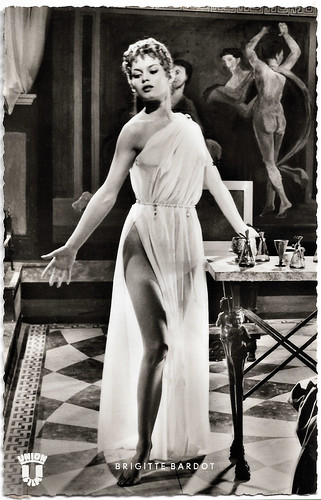
West German postcard by Kunst und Bild, Berlin-Charlottenburg, no. S 780. Photo: Union Film, Den Haag. Brigitte Bardot in Mio figlio Nerone/Nero's Mistress (Steno, 1956). The mural in the background is an imitation of the frescoes in the Villa dei Misteri in Pompeii.
Beautiful French actress Brigitte Bardot (1934) was the sex kitten of the European film industry. BB starred in 48 films, performed in numerous musical shows, and recorded 80 songs. After her retirement in 1973, she established herself as an animal rights activist and made vegetarianism sexy.

French postcard by Erpé, no. 555. Photo: Fox Film.
Shirley Temple (1928-2014) was an American film and television actress, singer, dancer, and public servant, but everybody knows her as the most famous child star of the 1930s. Shirley could do it all: act, sing, dance, and all at the age of five! Four years in a row, between 1935 and 1938, she was the top box-office draw for Hollywood. As an adult, she entered politics and became a diplomat, serving as United States Ambassador to Ghana and later to Czechoslovakia, and as Chief of Protocol of the United States.

Vintage press photo by Metro-Goldwyn-Mayer. Daliah Lavi and Kirk Douglas do the twist on the set of Two Weeks in Another Town (Vincente Minelli, 1962), filmed in Rome.
Israeli actress Daliah Lavi (1942-2017) was a ravishing beauty who appeared in dozens of European films in the 1960s and later also in American films. With her mini-skirts and thigh-high boots, she pursued sex symbol status via Italian erotic horror films and spy spoofs such as Casino Royale (1967). After her film career, she became a well-known Schlager singer in Germany.
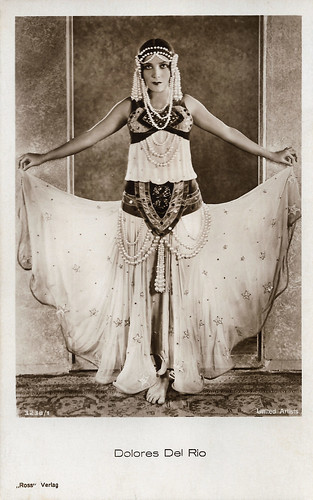
German postcard by Ross Verlag, no. 3238/1, 1928-1929. Photo: United Artists.
Mexican and American actress Dolores del Río (1905–1983) was a Hollywood star in the 1920s and 1930s, and one of the most important female actresses of the Golden Age of Mexican cinema in the 1940s and 1950s. Del Río was the first major Latin cross-over star in Hollywood and was considered one of the most beautiful faces that have emerged in Hollywood cinema. She also appeared in several European films.
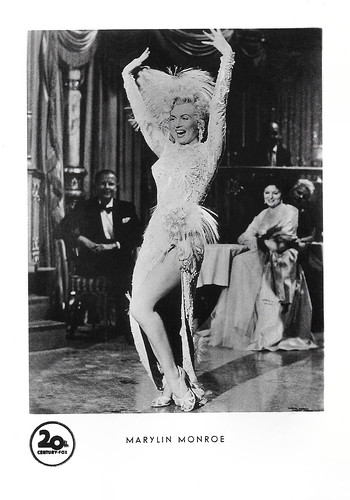
West German postcard by KuB (Kunst und Bild) / Filmwelt Berlin Archiv für Film-Geschichte, no. V 369, 1976. Limited anniversary edition of over 5,000 original KuB photo cards. Photo: 20th Century Fox. Marilyn Monroe in There's No Business Like Show Business (Walter Lang, 1953). Mistake alert: check out the spelling of her name on the card.
By 1953, Marilyn Monroe (1926-1962) was one of the most marketable Hollywood stars, with leading roles in three films: the noir Niagara, which focused on her sex appeal, and the comedies Gentlemen Prefer Blondes and How to Marry a Millionaire, which established her star image as a "dumb blonde". Although she played a significant role in the creation and management of her public image throughout her career, she was disappointed at being typecast and underpaid by the studio. She was briefly suspended in early 1954 for refusing a film project, but returned to star in one of the biggest box office successes of her career, The Seven Year Itch (1955).

British postcard, sent by mail in 1917.
Marguerite Clark (1883–1940) was an American stage and silent film actress, who after a Broadway career in 1900-1913 had a prosperous film career in the 1910s mainly at Famous Players. As a movie actress, at one time, Clark was second only to Mary Pickford in popularity.
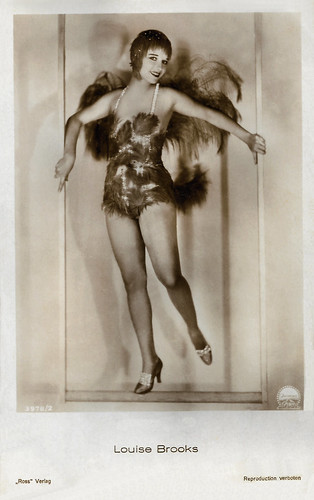
German postcard by Ross Verlag, no. 3978/2, 1928-1929. Photo: Paramount. Louise Brooks in The Canary Murder Case (Malcolm St. Clair, Frank Tuttle, 1929).
Legendary American dancer and actress Louise Brooks (1906-1985) set the trend of the bobbed haircut and personified the flapper, the rebellious young woman of the 1920s. She played the lead in three European silent film classics: Die Büchse der Pandora/Pandora's Box (1929), Tagebuch einer Verlorenen/Diary of a Lost Girl (1929), and Prix de Beauté/Miss Europe (1930).
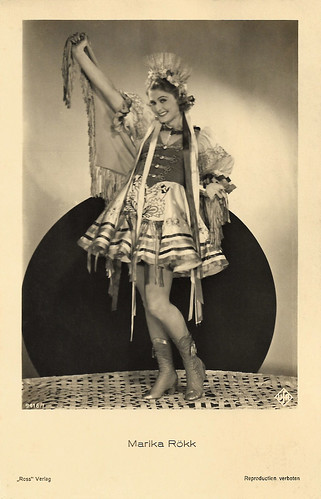
German postcard by Ross Verlag, no. 9416/1, 1935-1936. Photo: Ufa.
Egyptian-born singer, dancer, and actress of Hungarian descent Marika Rökk (1913-2004) was the last film diva of the Ufa. She was an immensely talented musical performer who could tap with the rhythm and vitality of her Hollywood counterpart Eleanor Powell, and switch to balletic movements with the conviction of Cyd Charisse. Her trademark was her Hungarian accent.
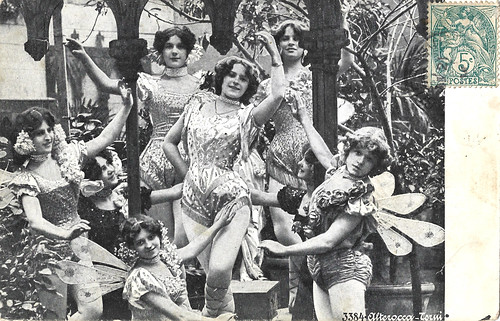
Italian postcard by Alterocca, Terni, no. 3384. Mailed in France. The postage stamp was issued in 1900, while in 1902 a new series was launched. Were these dancing fairies early film actresses?
No comments:
Post a Comment